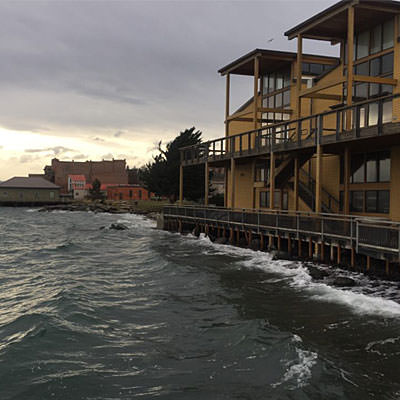Northeast outlook
When will the tides be higher than normal?
- September 17-21
- October 16-20
- November 14-18
Why will they be higher than normal?
- Mean sea level is generally higher in the early fall months in the northeast due to warmer, expanding ocean water and changes in weather patterns.
- A perigean spring tide will be occurring. This is when the moon is either new or full and closest to earth. Higher than normal high tides and lower than normal low tides will occur.
- In October and November, some locations along the Northeast coast are predicted to exceed the high tide flooding threshold based on tides alone.
What kind of impact might I expect along the coast?
- Due to the topography of the northeast (less low lying areas), high tides alone will not likely cause a significant impact on the coast unless accompanied by storm or strong winds.
Where might I expect high tide flooding?
Tide stations at the following locations have the greatest chance of seeing high tide flooding:
- Kings Point, New York.; Providence, Rhode Island; Boston, Massachusetts;Bar Harbor, Maine.
Mid-Atlantic outlook
Includes New Jersey, Delaware, Pennsylvania, Maryland, District of Columbia, Virginia.
When will the tides be higher than normal?
- September 16-22
- October 15-20
- November 14-18
Why will they be higher than normal?
- Mean sea level is generally higher in the early fall months in the Mid Atlantic due to warmer, expanding ocean water and changes in weather patterns.
- A perigean spring tide will be occurring. This is when the moon is either new or full and closest to earth. Higher than normal high tides and lower than normal low tides will occur.
What kind of impact might I expect along the coast?
- Minor tidal flooding along the coast, in particular in low-lying areas.
- If a storm occurs at this time, increased levels of tidal flooding and coastal erosion may occur.
- Lower than normal low tides will also occur.
Where might I expect high tide flooding?
Tide stations at the following locations have the greatest chance of seeing high tide:
- The Battery, New York; Bergen Point, New York; Sandy Hook, New Jersey; Cape May, New Jersey; Lewes, Delaware; Sewell’s Point, Virgina
Southeast outlook
Includes North Carolina, South Carolina, Georgia, Eastern Florida coast.
When will the tides be higher than normal?
- September 15-21
- October. 14-21
- November 13-18
Why will they be higher than normal?
- Mean sea level is generally higher in the fall in the Southeast due to changing weather patterns and typical short-term decreases in Gulf Stream transport.
- A perigean spring tide will be occurring. This is when the moon is either new or full and closest to earth, higher than normal high tides and lower than normal low tides will occur.
- In October and November, some locations along the Southeast coast are predicted to exceed the high tide flooding threshold based on tides alone.
What kind of impact might I expect along the coast?
- Minor tidal flooding along the coast, in particular in low-lying areas.
- If a storm occurs at this time, increased levels of tidal flooding and coastal erosion may occur.
- Lower than normal low tides will also occur.
Where might I expect high tide flooding?
Tide stations at the following locations have the greatest chance of seeing high tide flooding:
- Myrtle Beach, SC; Charleston, SC; Fort Pulaski, GA; Fernandina Beach, FL; Mayport, FL; Port Canaveral, FL
Gulf Coast outlook
Includes Texas, Louisiana, Mississippi, Alabama, Western Florida coast.
When will the tides be higher than normal?
- The Gulf Coast will not be significantly impacted.
Why won’t they be impacted?
- In many locations of the Gulf Coast, the tidal range is relatively small compared to other regions of the U.S, so they will not be as significantly impacted by a perigean spring tide.
West Coast outlook
Includes California, Oregon, Washington State.
When will the tides be higher than normal?
- October 17-19
- November 13-18
Why will they be higher than normal?
- Mean sea level is generally higher in the early fall months along the southern west coast due to warmer, expanding ocean water and changes in weather patterns.
- A perigean spring tide will be occurring. This is when the moon is either new or full and closest to earth. Higher than normal high tides and lower than normal low tides will occur.
- In November, some locations along the West Coast are predicted to exceed the high tide flooding threshold based on tides alone.
Hawaii and the Pacific Islands outlook
Includes Hawaii, Guam, American Samoa, Midway, Kwajalein, and Wake Island.
When will the tides be higher than normal?
- October 16-19
- November 14-18
Why will they be higher than normal?
- A perigean spring tide will be occurring. This is when the moon is either new or full and closest to earth. Higher than normal high tides and lower than normal low tides will occur.
Where might I expect High Tide Flooding?
- Tide stations at the following locations have the greatest chance of seeing high tide flooding - Kwajalein, Marshall Islands.
ALASKA outlook
When will the tides be higher than normal?
- October 16-20
- November 13-18
Why will they be higher than normal?
- A perigean spring tide will be occurring. This is when the moon is either new or full and
- closest to earth, higher than normal high tides and lower than normal low tides will occur.
What kind of impact might I expect along the coast?
- Due to the topography, in particular for southeast Alaska (less low lying areas), tidal flooding will generally not have a significant impact on the coast unless there is a severe storm.
 An official website of the United States government.
An official website of the United States government.


Social